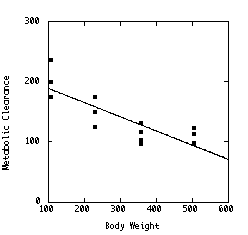
The following data come from a paper "Changes in growth hormone status related to body weight in cattle" with x = body weight (kg) and y = metabolic clearance rate.
x: 110 110 110 230 230 230 360 360 360 360 505 505 505 505 y: 235 198 173 174 149 124 115 130 102 95 122 112 98 96
(a) Fit a straight line to the data by least squares. Plot the data and the fitted line on a graph. Can metabolic clearance rate be predicted as a linear function of body weight? Present your analysis in an ANOVA table with F-tests for non-linearity and for the slope of the regression line. State your assumptions and your conclusions.
(b) What metabolic clearance rate would you predict for a body weight of 300 kg?
(c) Give a 95% confidence interval for s2 = Var( y | x ).
(a) The analysis below was done in Systat, but you should have no difficulty duplicating it on your calculator, even under examination conditions.
Begin by computing the following sums, sums of squares, and sum of products:
n = 14, S x = 4480, S y = 1923 S x2 = 1733500, S xy = 544730, S y2 = 288013 Lxx = 299900, Lxy = -70630, Lyy = 23875.2143
Fit a straight line and compute the simple linear regression ANOVA:
DEP VAR:CLEARANC N: 14 MULTIPLE R: 0.835 SQUARED MULTIPLE R: 0.697
ADJUSTED SQUARED MULTIPLE R: 0.671 STANDARD ERROR OF ESTIMATE: 24.5646
VARIABLE COEFFICIENT STD ERROR STD COEF TOLERANCE T P(2 TAIL)
CONSTANT 212.7209 15.7841 0.0000 . 13.4769 0.0000
WEIGHT -0.2355 0.0449 -0.8347 1.0000 -5.2504 0.0002
ANALYSIS OF VARIANCE
SOURCE SUM-OF-SQUARES DF MEAN-SQUARE F-RATIO P
REGRESSION 16634.2011 1 16634.2011 27.5666 0.0002
RESIDUAL 7241.0132 12 603.4178
There are 4 distinct level of Body Weight in the data set. Treat Body Weight as a factor at 4 levels and analyse as a one-way ANOVA:
LEVELS ENCOUNTERED DURING PROCESSING ARE:
WT_GRP
1.0000 2.0000 3.0000 4.0000
DEP VAR:CLEARANC N: 14 MULTIPLE R: 0.904 SQUARED MULTIPLE R: 0.817
ANALYSIS OF VARIANCE
SOURCE SUM-OF-SQUARES DF MEAN-SQUARE F-RATIO P
WT_GRP 19514.2143 3 6504.7381 14.9157 0.0005
ERROR 4361.0000 10 436.1000
Combine the results from the two ANOVA tables above to get a Regression Analysis with a Pure Error term and a test for Lack of Fit:
(This step was done manually; some statistics packages can't do an analysis like this with Pure Error.)
ANALYSIS OF VARIANCE SOURCE SUM-OF-SQUARES DF MEAN-SQUARE F-RATIO P REGRESSION 16634.2011 1 16634.2011 38.1431 0.0001 LACK OF FIT 2880.0132 2 1440.0066 3.3020 0.0792 ERROR 4361.0000 10 436.1000
The lack of fit F-test is not significant at the 5% level; hence, over the range of body weights studied, linear regression is an adequate model for Metabolic Clearance. The regression is significant, and accounts for 90% of the variation.

(b) From the fitted line: E( y | x = 300 ) = 142.07
(c) s2 = MSPE = 436.1 on 10 df.
However, the lack of fit test was not significant, so if you prefer you could use the residual mean square from the regression ANOVA to estimate the conditional variance and get 2 more df:
s2 = MSR = 603.4178 on 12 df.
95% Confidence Interval for the conditional variance s2:
Using s2 = MSPE gives (436.1/(20.48/10), 436.1/(3.25/10)) = (212.9, 1324)
Using s2 = MSR gives (603.4178/(23.34/12), 603.4178/(4.40/12) = (310.2, 1646)